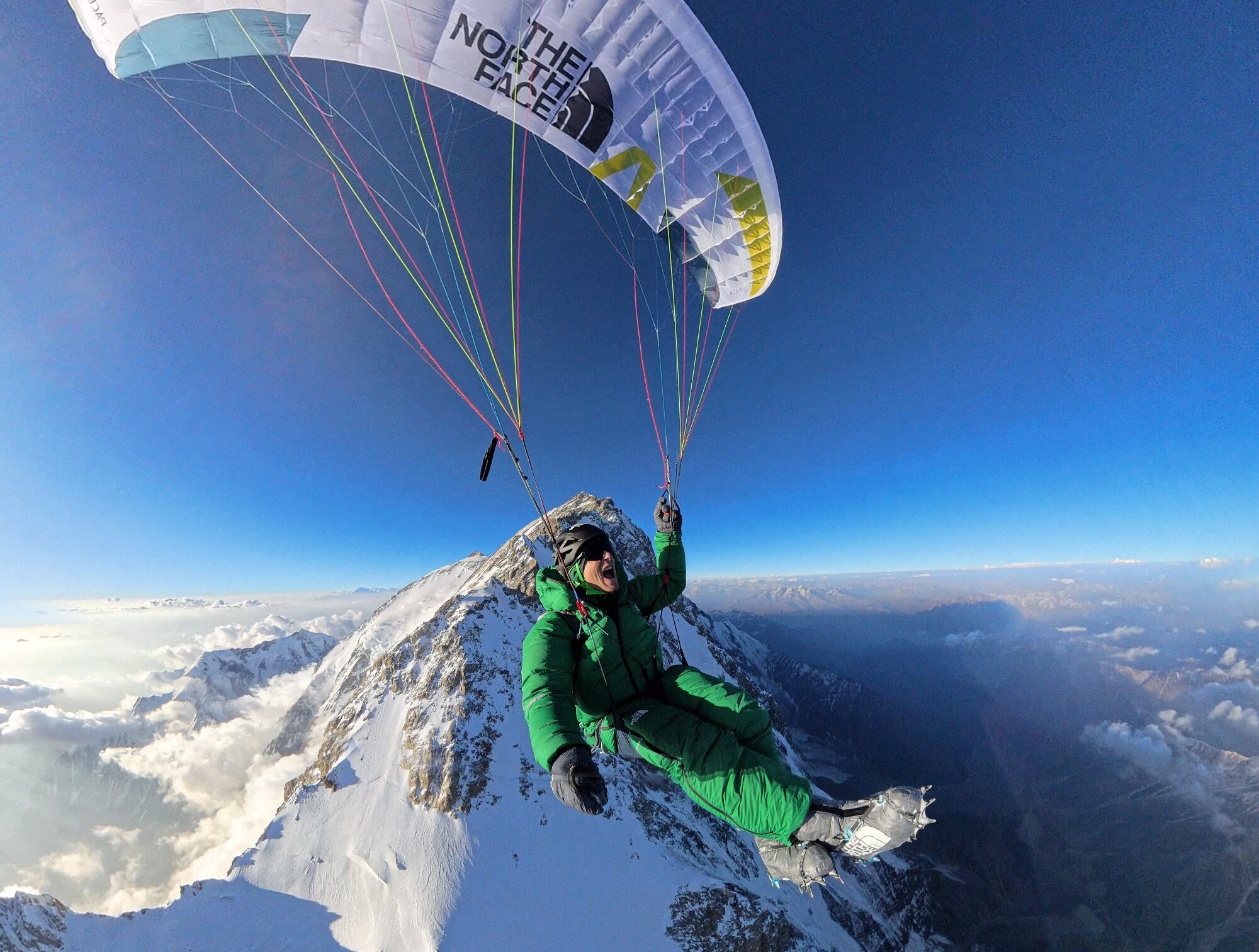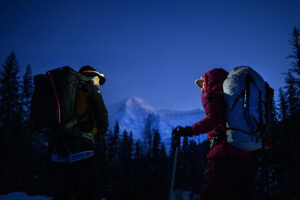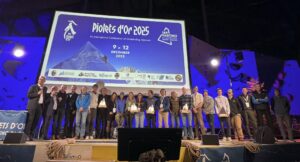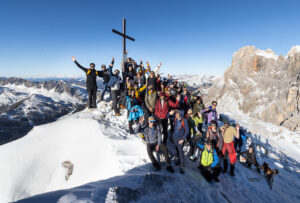German climber David Goettler had unfinished business with the Rupal side of Nanga Parbat: “I needed to prove I’m able to claim an 8,000’er in the style I like and off the normal route.”
Back in Europe after climbing the Schell route and paragliding from the summit, Goettler is over the moon. He’s not only ecstatic about the achievement, but also because he finally succeeded on a personal bet that has molded his high-altitude climbing career.
“After all these attempts and years I put into this project, it paid off and I am very happy,” Goettler said. “I have fulfilled this dream, and flying down, it’s kind of the cherry on the top, even if it was not right from the summit.”
Prize for persistence
In some cases, when a climber achieves a project attempted and planned for years, they feel a kind of emptiness. Goettler, on the contrary, has found that it has motivated him for future climbs.
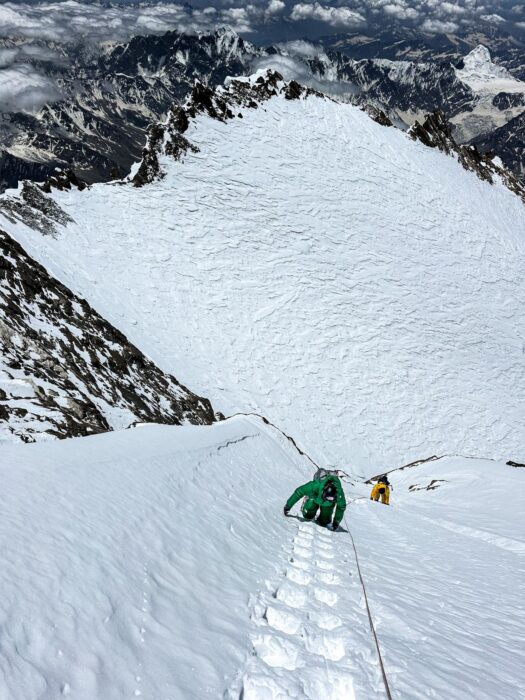
The final section of Nanga Parbat. Photo: David Goettler
“The recent success has increased my motivation to chase similar projects because I have climbed Nanga Parbat in exactly the style I wanted. I have learned that it sometimes takes a lot of attempts, but in the end, with persistence and patience, it pays off.”
This is an important issue for Goettler, who follows strict safety standards on his climbs. His goal is to complete a climb and descend safely, without “having to get epic,” as he terms it.
“Through the years and the attempts, I turned around so many times because some small things didn’t fit right or it was not perfect. Of course, I questioned myself. Perhaps I was not pushing hard enough? But in the end, I have proven that I can achieve my goals in what I consider the right way,” Goettler explained.
Safe, not boring
Goettler concedes that his focus on safety “might look boring for audiences and the media, because I avoid drama. I am aware others push these limits far beyond [what I choose to do] and play with fire. But each climber has to decide this for themselves.”
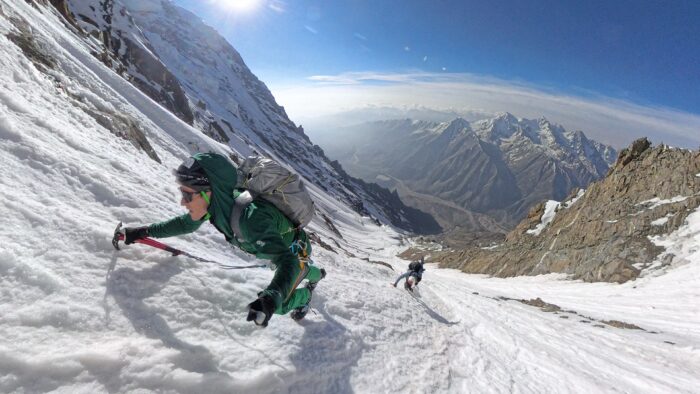
Photo: David Goettler
“Of course, bad luck is always possible, and you can always end up in a difficult situation without forcing it. However, if you push the limits again and again and again, you may need to start questioning your approach to mountaineering,” Goettler told us.
On every attempt, Goetller studied his mistakes and tried to fix them for the next round. So, what changed on this attempt? What was the final finetuning that led to success instead of retreat? Was it just luck?
More than luck
“I believe it’s not only luck, although we were indeed lucky with the weather window and with the conditions. The mountain was very dry this year, which made the going up to 6,000m quite complex, especially for Boris and Tiphaine [climbing partners Boris Langenstein and Tiphaine Duperier of France] who wanted to ski down from the top,” Goettler said. “However, from 6,000m up, conditions were way better.”
Goettler explained that, although the climbers had to break trail all the time, the snow was not as deep as in wetter years. As seen in videos from the mountain, the climbers wore small snowshoes, which made progress easier on the snowy patches.
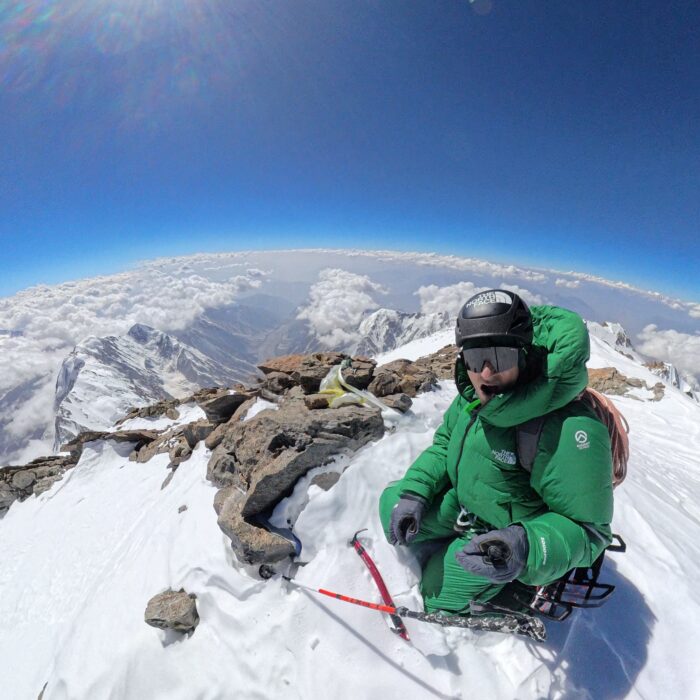
David Goettler on the summit of Nanga Parbat. Photo: David Goettler
The team enjoyed an extraordinary weather window. “For three days we had little wind and no precipitation,” Goettler recalls. “However, from my experience climbing in Pakistan since 2004, I had learned that temperatures are rising in recent years, so we knew we would need to make the attempt early in the season. We still almost got there too late!”
Fine-tuned tactics
Reflecting on the increasing temperatures, Goettler believes expeditions in the Karakoram may consider an earlier start, even if that means overlapping with the Spring season in Nepal.
Goettler also made a key tactical adjustment for this final attempt.
“The summit day from the last bivy at 7,400m is extremely long, and the last time I underestimated it. On the maps, the terrain looks so vertical that you think it cannot be too long, but it is! It’s a long way to the top, especially because of the traverse of the Diamir side,” Goettler said.
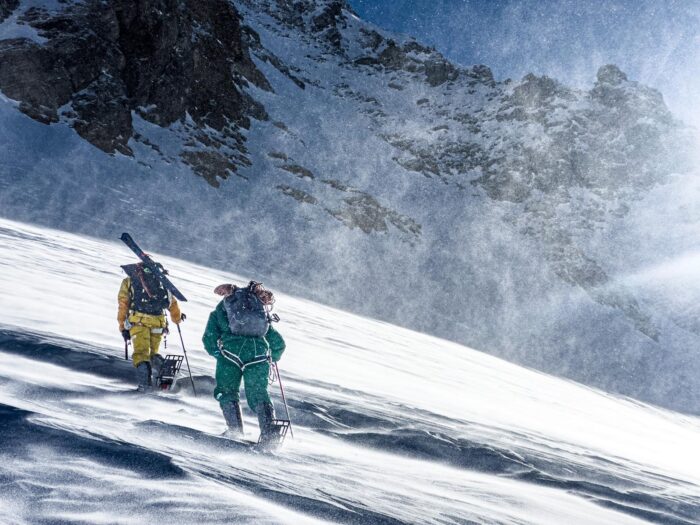
Climbing on a windy day with snowshoes. Photo: David Gooettler
“Therefore, this time we took a tent, a stove, and a sleeping pad with us for the summit day. That way, we could always stop, pitch the tent, get shelter from the wind, and have a rest, no matter the altitude. Either on descent or during the ascent, if the weather turned for the worse, the safety items gave us confidence to tackle a longer summit day.”
They reached the summit shortly after 3 pm local time, which is late on an 8,000’er. But they had perfect weather, so an evening descent was not concerning.
“However, it was just a little bit too much wind to feel comfortable taking off and paragliding directly from the summit,” Goettler noted.
The descent
With too much wind to take off from the summit, Goettler started down with Langenstein and Duperier. The two French climbers put on their skis at the top and started down the summit ridge to the south summit of Nanga Parbat; Goettler followed on foot. The skiing was slow at that altitude, so he didn’t get left behind.
“At around 6:30 pm, we reached 7,700m. Here, the ridge opens up and the terrain falls away in a huge, steep snow field,” Goettler said. “It was still a bit gusty, but I felt confident to take off.”
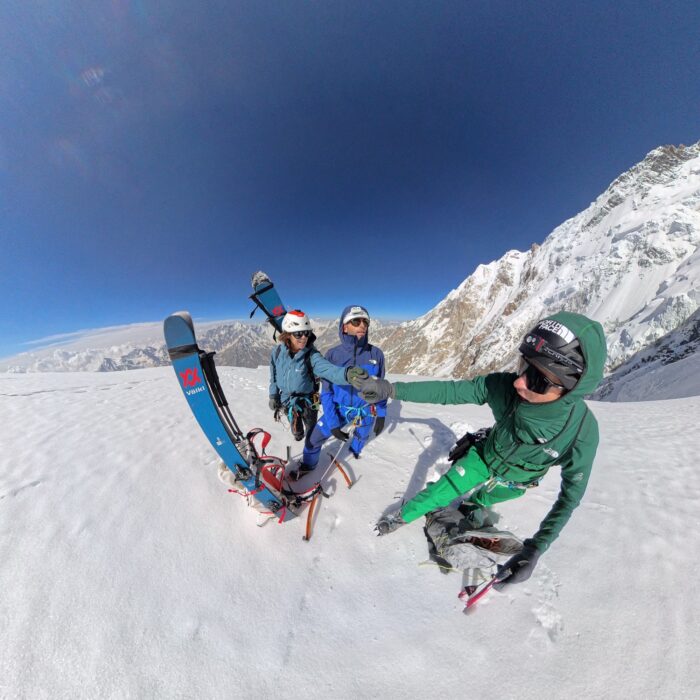
The team. Photo: David Goettler
The following 30 minutes will always remain in Goettler’s memory as one of the most amazing, surreal moments of his life.
“I took off, first flying toward the flank of the mountain, along the traverse of the Diamir side and right over the Mazeno Col back to the Rupal face, where I dropped down and landed right beside our Base Camp. It was one of my best and craziest moments in the mountains so far.”
Thirty minutes vs. three days
Goettler’s arrival shocked the Base Camp cook, who didn’t expect anyone for dinner so soon after hearing the summit news. He ran out of the tent when he heard Goettler calling.
Going down took much longer for Langenstein and Duperier. “The traverse is no more than 50 vertical meters, but it’s all ups and downs, which can take an extremely long time when you’re on skis,” Goettler said. “They used the tent, improvising a bivy for the night. The following day, they continued to the place of our last proper camp, at 7,400m, right at the access point to the Rupal side, and they spent another night there.”
The descent down the Rupal Face was so rough that the French climbers still needed another stop. They halted on the ridge at 6,000m because the lower part of the mountain was so prone to rockfall that it could only be downclimbed when frozen, between midnight and 6 am.
Their long descent provided Goetller with a new experience: waiting in base camp for partners on the mountain. “It was quite intense,” he said. “We could only communicate over the radio when they were on the Rupal Face. While they were on the other side, only SMS over InReach worked, and there was so little we could say. It was unnerving not knowing where they were and how they felt.”
The art of flying
Indeed, flying down proved an amazing way to descend from a high-altitude summit. It is safer, faster, and spectacular. Benjamin Vedrines and other French climbers experienced it on K2 last year, where it also worked wonderfully.
“I’m sure we will see it more and more, but it will not become the norm,” Goettler said. “Most days, flying from a summit or a high point is not possible. Even with modern, more accurate forecasts, you need to be really lucky with conditions, and then high-altitude paragliding requires extra skills. Often, I carry my wing up and I can’t fly.”
Goettler recalls that he took his wing to Nanga Parbat last year when he attempted the climb with Vedrines, but he was unable to fly from any higher than 5,500m because of high winds. Equally, he brought the wing up Baruntse in spring, but he had to return on foot in foggy weather.
“Gliding makes life so easy when it works. You fly with zero worries about rockfall, avalanches, exhaustion, or anything. In 30 minutes, you’re back down to safety.”
Team workflow
Goettler has attempted Nanga Parbat on five occasions with different climbing partners. He has climbed with Herve Barmasse, Mike Arnold, and Benjamin Vedrines. Last year, he met Langenstein and Duperier on Nanga Parbat. They shared the same goal, so they quickly made plans to join forces in 2025.
“It was one of the best teams I have ever been on, even though our characters are rather different. I worked really well, it’s so good to have a group where you spend no energy managing the team dynamics,” Goettler said.
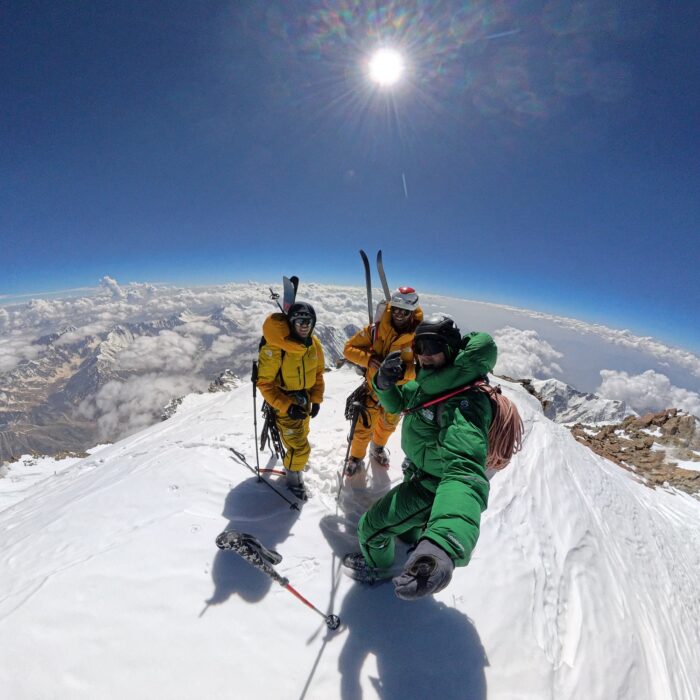
Group summit picture. Photo: D. Goettler
The climb
The climb was described by Goettler in a series of clips that he posted on social media. Here’s a summary and the footage:
Day 1: Latabo Base Camp to Camp 1 (6,000m)
Goettler notes that the team had made a previous climb to this point to check conditions. They left a small gear deposit.
“For the ultra purists, our ascent wouldn’t be ‘alpine style,’ but I’m still happy to call our climb alpine style because there wasn’t a single meter of fixed rope, no set camps, and no external help.”
The team climbed with a 50m rope, some pitons and cams, one tent, and food and gas for five days.
Day 2: The ridge section and snow fields between 6,000m and 6,800m
“The route goes along a sharp ridge, then you have to cross big, wide open snowfields,” Goettler described.
This is the section where the climbers enjoyed better conditions than the previous year, with not so much snow. Still, they used small snowshoes for some parts.
Day 3: To the third bivouac at 7,400m
For Goettler, this section is key to predicting whether the climb will be successful. Luckily, the forecasts were accurate, and the winds dropped.
Day 4, part 1: The traverse, 7,400m to 7,800m
Goettler turned around on this section on two previous occasions. They made much faster progress this time.
“The conditions on the summit ridge were exceptional, as was the weather, but the traverse itself has endless ups and downs, which makes for an exhausting return,” he noted. “We swapped leads whenever someone needed a break, and with this teamwork, we maintained a slow but consistent pace to the Merkel Notch, just below the final unknown section of the route.”
Day 4, part 2: From 7,800m to the summit
Once in unknown terrain, after the Merkel notch (a small col), they climbed a technical rocky section and crossed a snow field that took them to the south summit and then the main summit of Nanga Parbat.
“[The rock section] wasn’t super hard, but difficult enough to get the 50m rope and camalots out, which, at close to 8,000m, is spicy enough,” Goettler recalled. “When we finally stood on the summit of Nanga Parbat, 14 hours after leaving our last camp, each of us knew that without the others we wouldn’t have made it. A feeling and a moment so powerful I won’t ever forget.”
